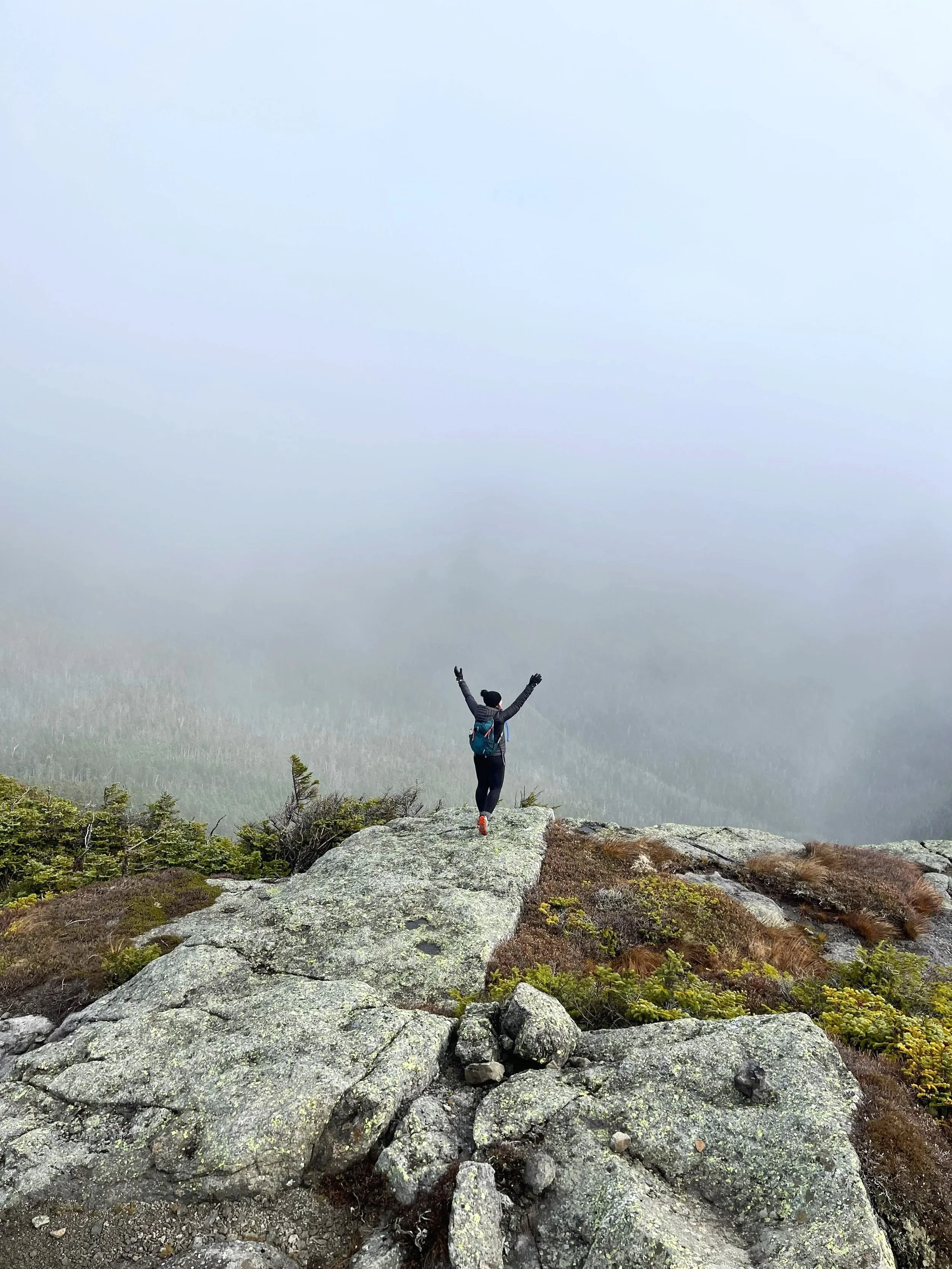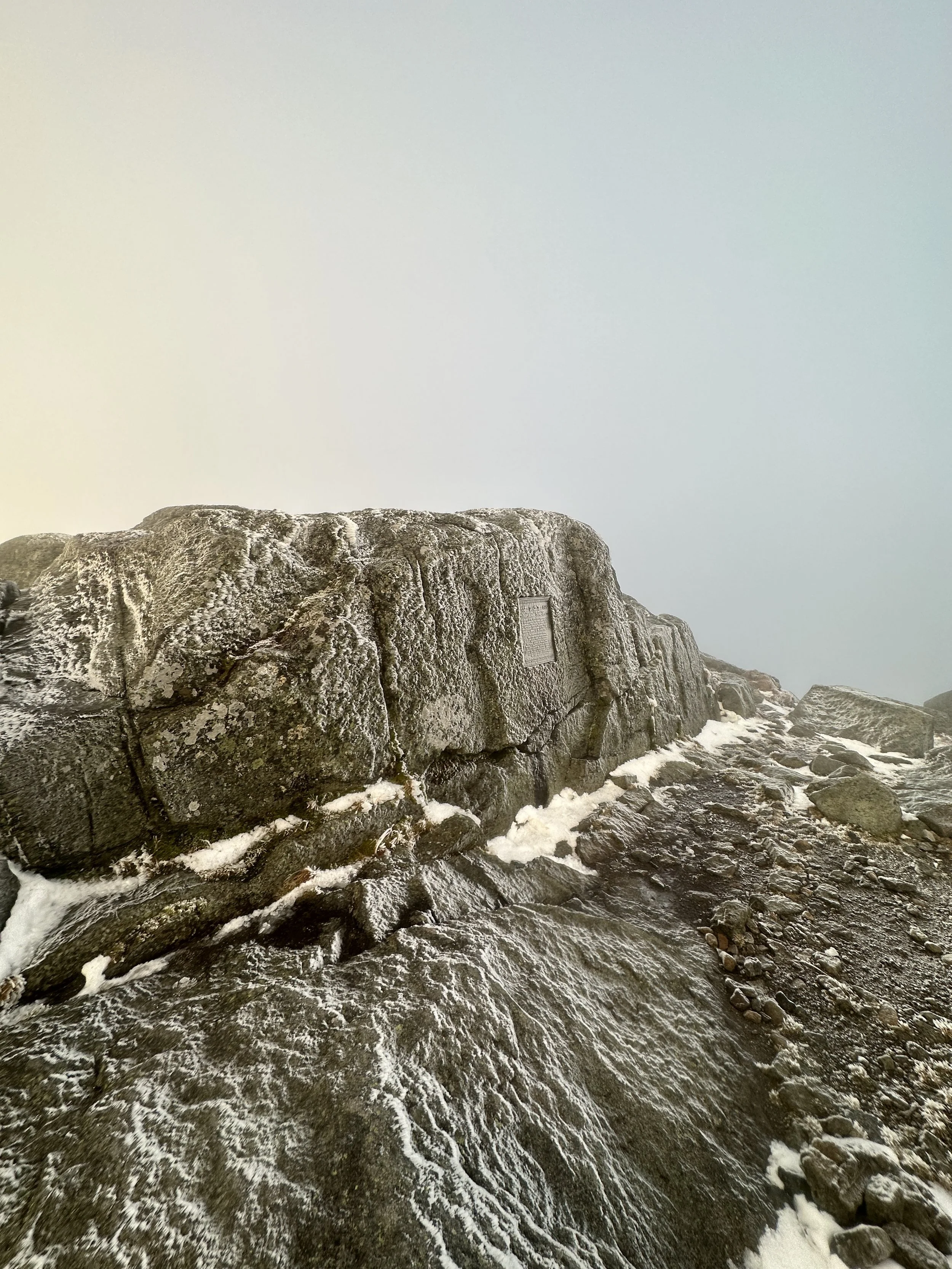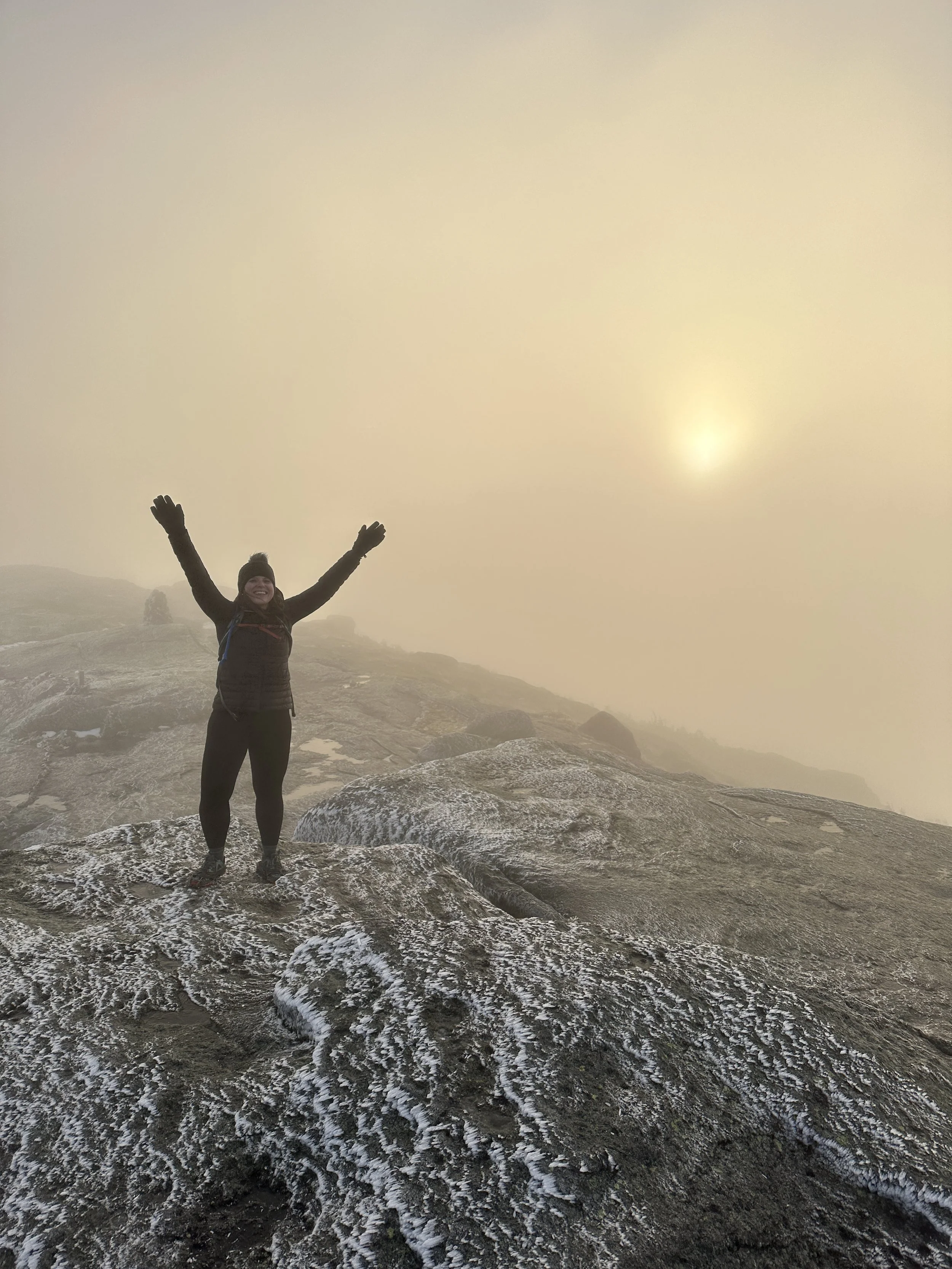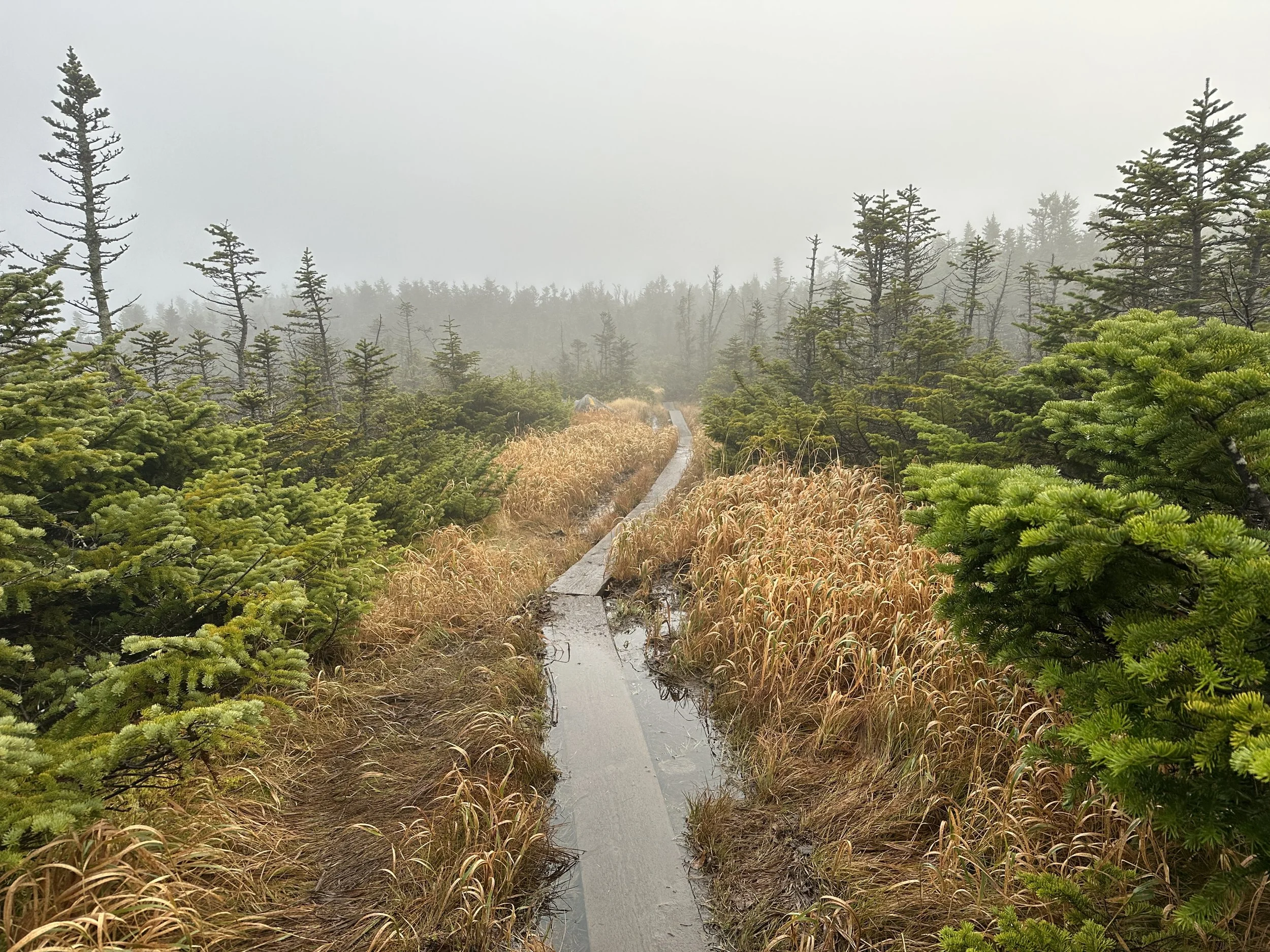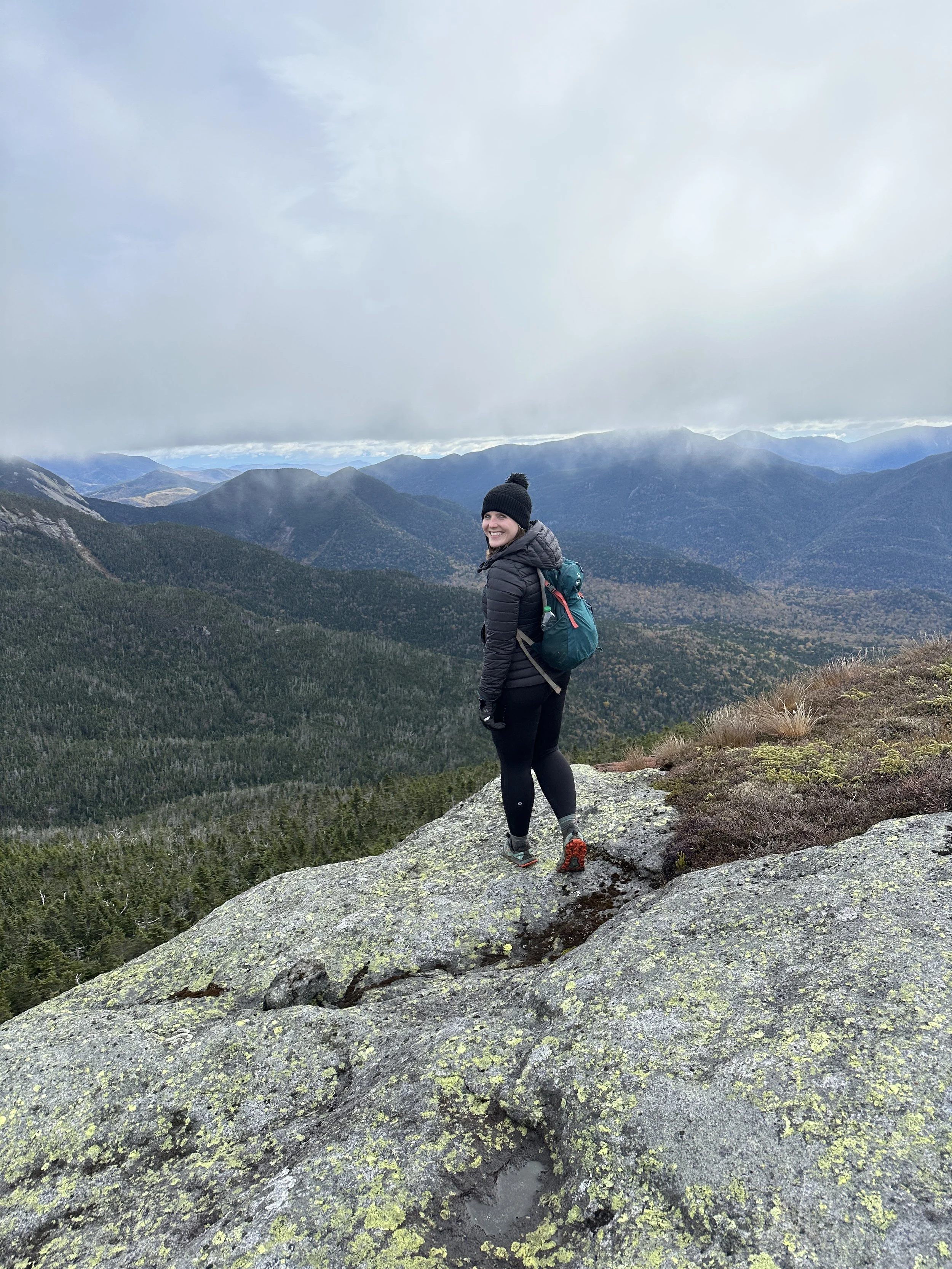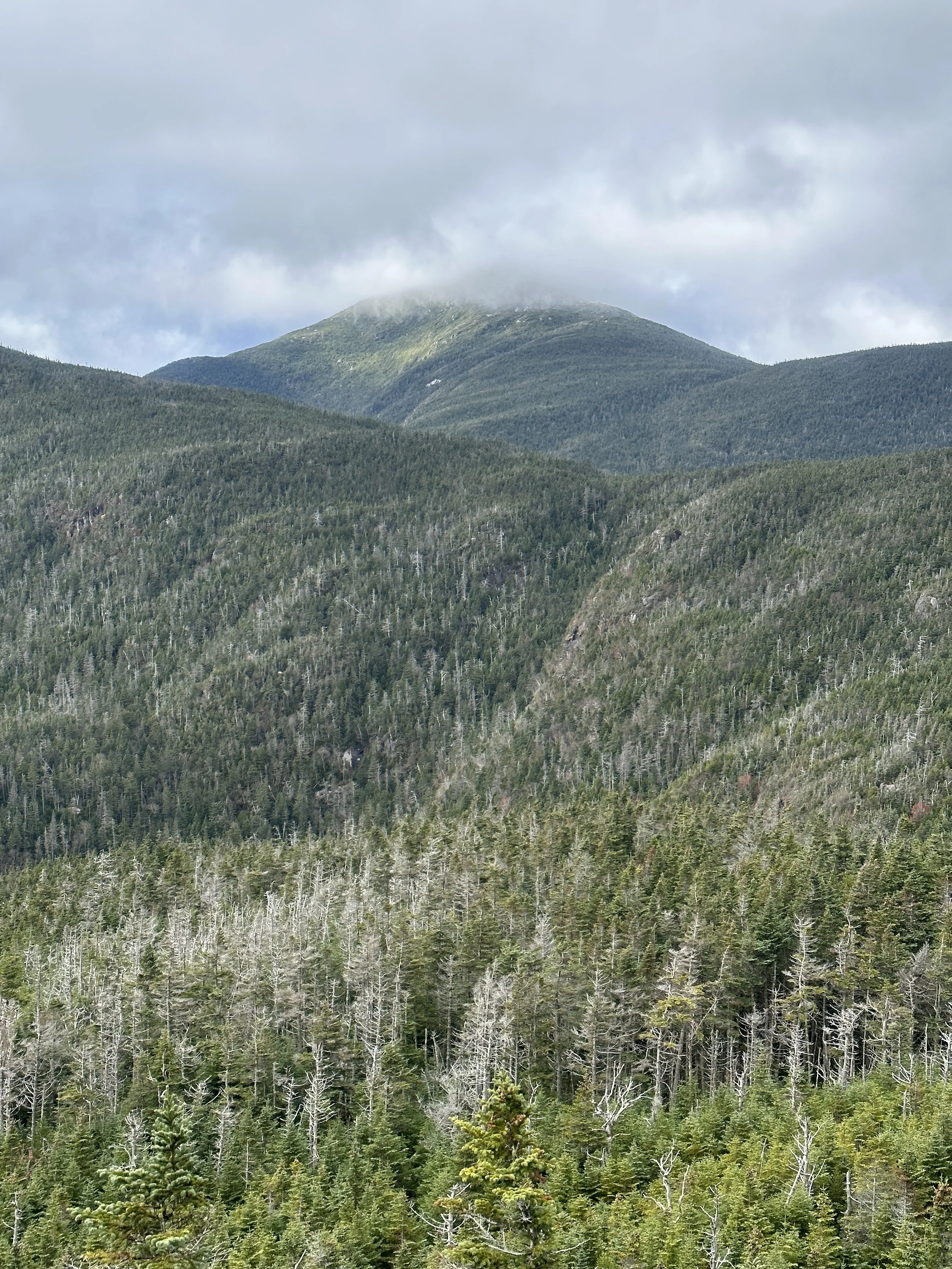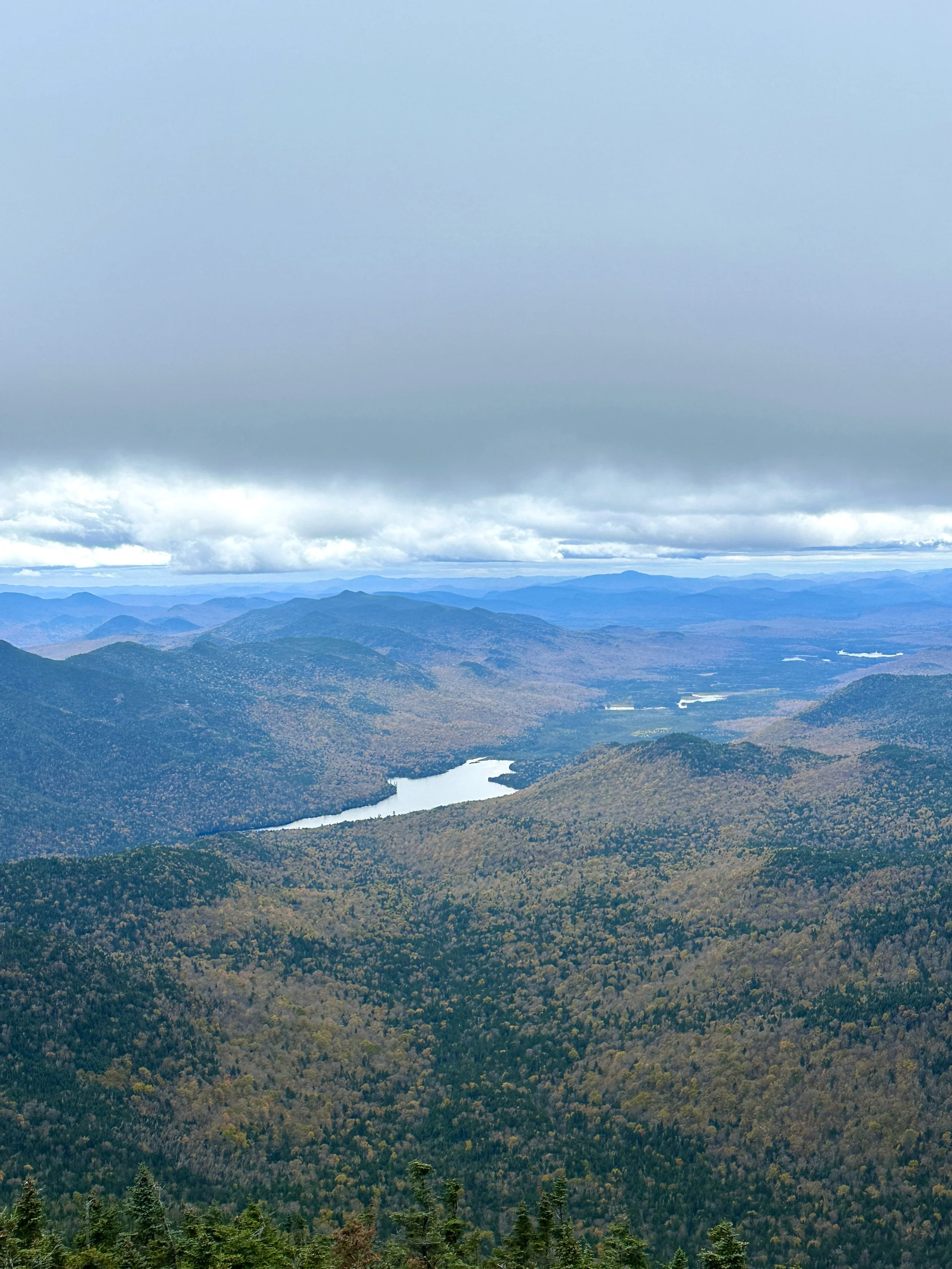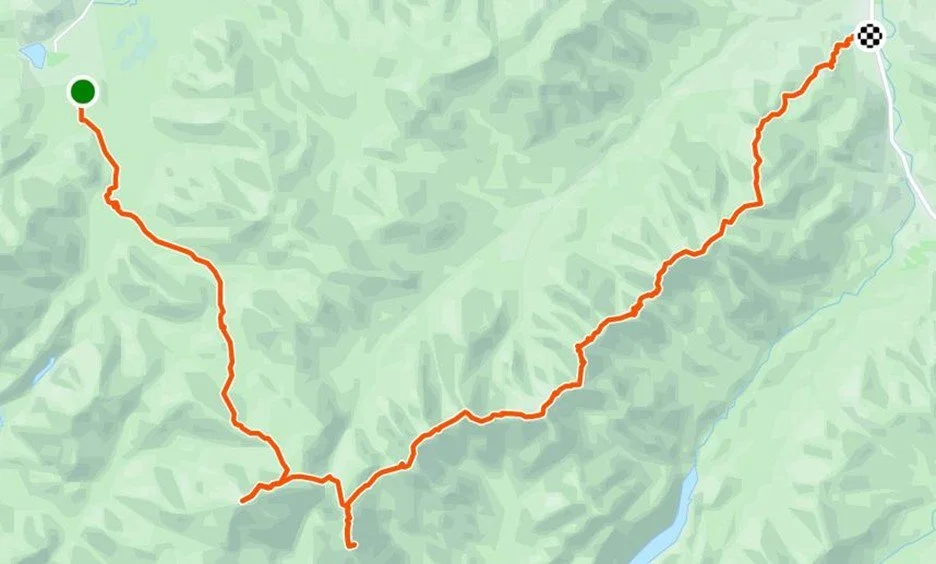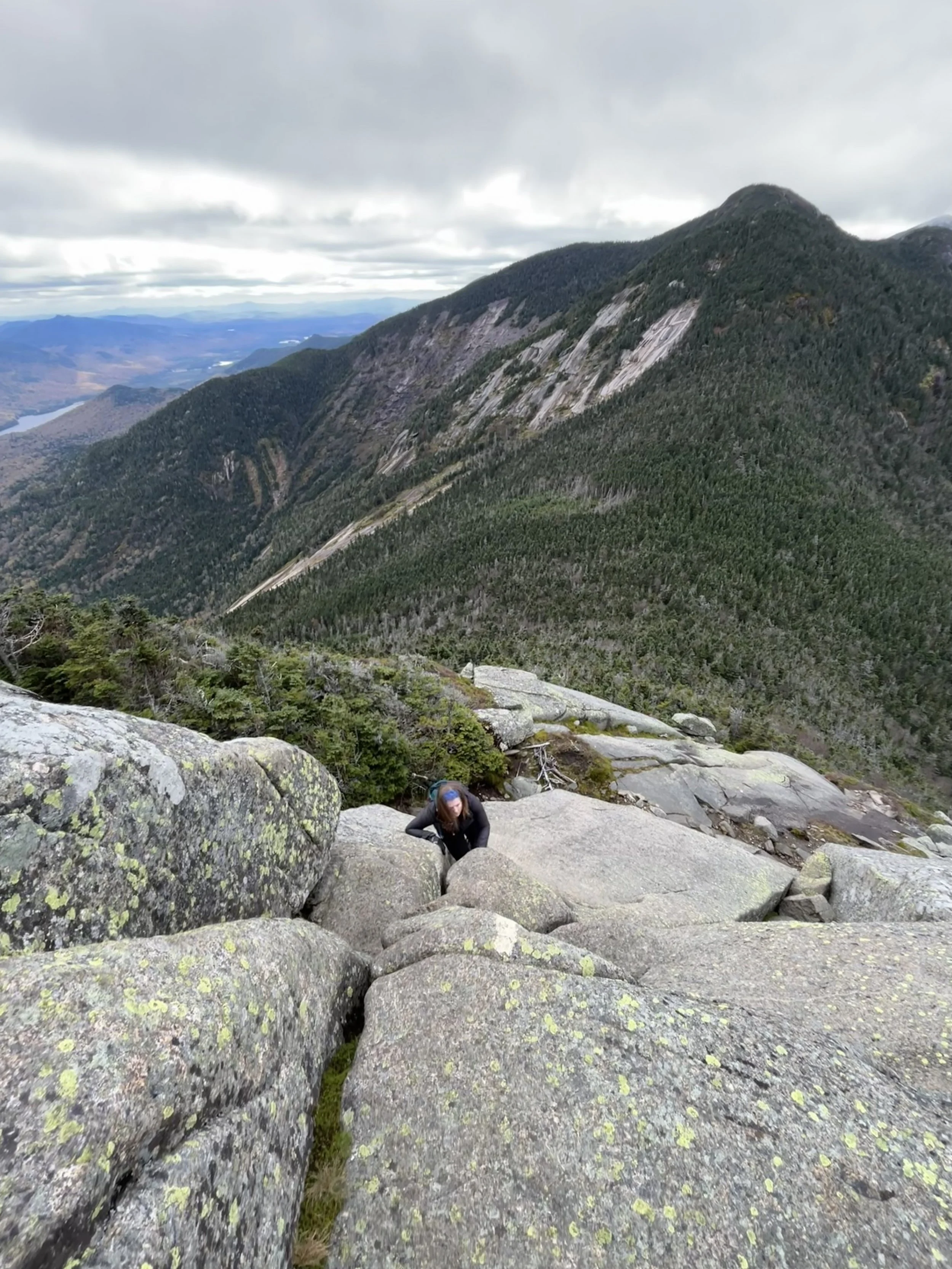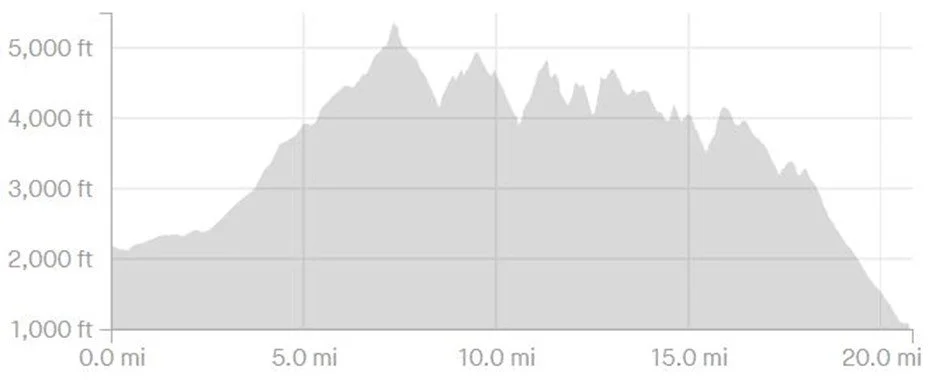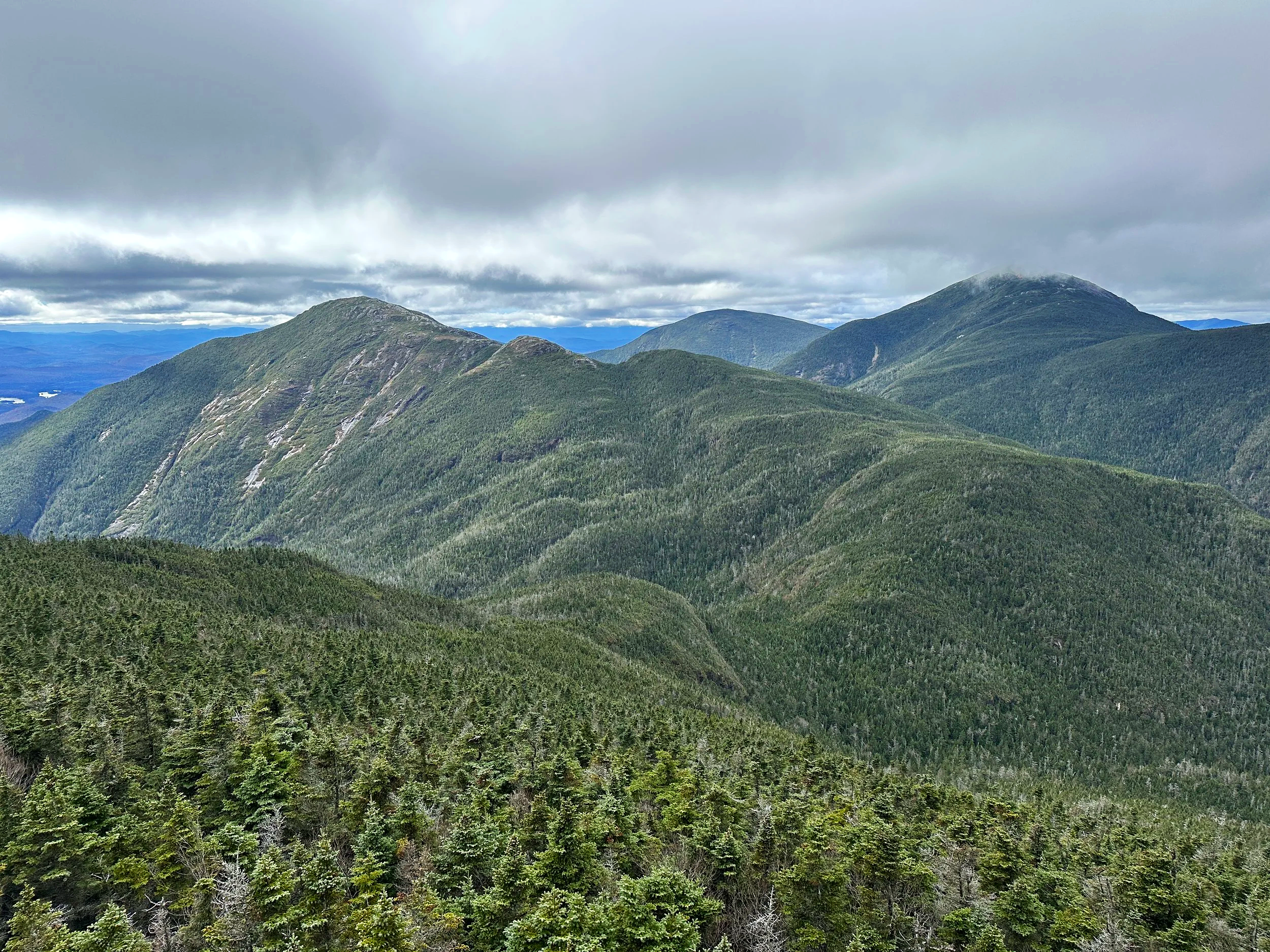Hike the Adirondacks’ Great Range Traverse in One Day
Hike 8 of the ADK 46 over 20.8 miles and 8,300 feet along the Great Range Traverse. Do it in a day for the Northeast Ultra 8! Here’s all you need to know about the GRT.
Summit of Haystack in the Adirondacks.
New Year resolutions never stuck for me, but for the past several years, goals I set on my birthday have. With every passing year, my individual goals differ, but the categories stay the same (hiking, traveling, fitness, and finances). 2023 was the year I took my hiking goals up a notch.
After wrapping up the New England 67 4,000 footers, I had the Adirondack 46 on my mind. When I first moved to Massachusetts, I hiked one of the 46 a year. I thought I’d keep that up to have a lifelong hiking goal. If I started hiking them once a year at twenty-five, I’d have a goal to pursue past retirement. I should have known better. I always considered the Adirondacks rugged. The trails aren’t as easy to navigate as the Whites, and the mileage increases tremendously with the 46. The Whites were challenging sure, but the times I spent in the Adirondacks I rarely came across other hikers, particularly on the grueling days.
I made my way up to 19 going into May, but I was still too scared to officially write down “become a 46er this year” on my list. So I didn’t. I kept it to myself and decided any free weekend off of summer school I had, I’d drive to my favorite place. And that’s exactly what I did. By the end of September 2023, I only had six remaining peaks. I couldn’t believe it. These six 4,000 footers happened to also all be along the Great Range, and like my NH 48 finish, I knew I wanted to end on an epic adventure.
That’s where the single-day Great Range Traverse came in. Roughly a twenty-mile hike with around 9,000 feet of elevation gain. I have had longer days and bigger climbs than this one, but the Adirondack terrain is truly on a different level. Particularly on this one with the famous Saddleback cliffs. I knew I wanted company not only for morale, but as a safety measure. Thankfully, there are others out there who love these mountains and who jump right in when it comes to these challenges instead of shy away. Tom joined me, despite already being a 46er, because he was working on his Northeast Ultras. Completing this hike would not only make me a 46er, but it would also complete another of the Northeast Ultras. The NEU is a list of nine intense hikes in the Northeast that range from 20-52 miles. Told you I wanted an epic adventure, right?
We agreed to start hiking by 3:30 am, so I started the drive from Western Massachusetts a little before midnight to arrive at the trailhead. After dropping one car off at the Rooster Comb trailhead, we made our way to the Adirondack Loj for our official start. Car parked at the start of the Van Hoevenberg Trail and bags packed. We were ready.
Van Hoevenberg Trail > Mt. Marcy (5,305’)
Darkness kept us company as we began our hike along the Van Hoevenberg trail. We made our way to Marcy Dam way faster than I imagined. We chugged along, and then our ascent to New York’s highest point truly began. And so did some stomach issues for me.
Slowly but surely, we made our way. Shockingly, we made it to the summit in time for sunrise. Sadly, spikes were required as winter welcomed us at 5,000 feet. It was a socked in summit, but the sun was visibly rising. It looked like a fireball in the sky. The only other time I experienced a moment like this was atop Sugarloaf in Maine for a New England 67 hike. I had the summit to myself as the sky burst into fiery flames.
Again I found myself at a summit, with Tom this time, that felt like we were on another planet. We took it in for a moment. My hands were frigid and the winds were whipping, so we headed back down. Once we were under tree line again, we took a longer break. Tom let me borrow his warm gloves and we headed to our next summit: Haystack.
Mt. Marcy via Van Hoevenberg Trail > Phelps Trail > Haystack (4,915’)
We descended over 1,000 ft before having to summit Little Haystack (4,662’) en route to Haystack. The last stretch along the Haystack Trail led us there. Haystack stands at 4,915’ and was a new summit for me. This one came with a sliver of an opening in the sky’s parting clouds. Some bits of foliage remained in the distance, and we could see Mt. Marcy was clearing up a bit as well.
The sky cleared up a bit for us atop Haystack.
Haystack > Basin (4,817’) >
Saddleback (4,511’)
Haystack was an out-and-back, like Marcy, so we went back down the Haystack Trail and back onto the State Range Trail. That was our last out-and-back on trail. I didn’t feel great because I wasn’t eating, but also mentally I knew the toughest part wasn’t over yet. I’m glad we hiked Marcy first and went the route we did because a large amount of climbing had already been accomplished, but the part I psyched myself out the most by was approaching: the Saddleback cliffs.
A small section of the Saddleback cliffs.
Saddleback > Gothics (4,675’) > Armstrong (4,331’)
The cliffs were no joke. I’m not tall, so it was very helpful to have Tom go first and I watched his hand and foot placements. Even with him in the lead, I was terrified. I watched a few videos of the cliffs and chatted with hikers around my height who went up the cliffs, but nothing really prepares you. Already hiking a few mountains prior to this moment probably didn’t help. I saw my life flash before my eyes a few times, but I did it. At the top, we sat and ate a bit. That was when I realized my hands were still shaking. I’m not someone with a fear of heights at all, so that was definitely alarming. As we took our break, other hikers approached us, telling us someone had fallen and they assisted them with a rope that hiker had packed. Safe to say I won’t be repeating this section for some time (re: ever).
I was just grateful the “tough” section was done. I told myself the cliffs were the worst part and it would be smooth sailing after that. The Adirondacks, of course, are never smooth sailing.
Next up was our approach to Gothics. I hiked this one years before, very early on in my 46er journey. I was a beginner hiker looking for great foliage views and I found them! I hoped to do Sawteeth at that time too, but hikers at Gothics’ summit told me they crossed paths with black ice, and I played it safe since I didn’t have spikes at the time.
Since I had already been up Gothics and wasn’t traumatized back then, I thought I was in the clear. Then came the cables. I focused so much energy and research on the Saddleback cliffs that I didn’t realize Gothics had its own exciting adventure. Physically I was already weak from the hours we had been on trail, so when I saw a straight incline where using cables was practically a requirement for a great stretch of trail, I realized I was in for quite the arm workout.
As we ascended, a couple hikers descended. I was just thankful to not have to descend this section. Another moment of gratitude for taking the route we did. It looked worse than it was and soon after we headed to Armstrong. I wish I could say more about Armstrong, but I have no memories of this point. I was just glad to be done with the challenging sections.
Armstrong > Upper Wolfjaws (4,203’) > Lower Wolfjaws (4,177’)
With Armstrong under our belts, we had a couple climbs left. At this point, we were chasing the sun. We ascended Upper Wolfjaws and went onwards to Lower Wolfjaws. Neither were too memorable until we found an opening on Lower Wolfjaws just after the sun set behind the mountains. Tom gifted me a 46er patch so I officially became a 46er then. What a moment.
Lower Wolfjaws > Hedgehog Mountain (3,376’) > Rooster Comb Trailhead
I finally felt relief that the day was over, despite us already watching the sun set on the day. It was defeating to realize about five miles of trail remained and we’d have to descend roughly 3,000 feet. My feet were wrecked. Mentally, I was exhausted. Tom took the lead on the descent. We headed down the W. A. White Trail toward Hedgehog Mountain, followed by the Hedgehog Trail, and lastly Rooster Comb Trail. Tom safely got us back to the Rooster Comb trailhead. Honestly couldn’t have gotten out of the woods without him.
I felt an amalgam of emotions as we drove back to my car. Delirium was the strongest feeling in that moment because I hadn’t eaten and I was absolutely exhausted.
Days later I realized what I achieved.
I had just finished the 46. I was officially a 46er – something I never saw myself achieving. People usually laugh when they find out I finished on Lower Wolfjaws (a rather unimpressive peak), but then I mention it was part of the Great Range Traverse that day. Not only did I accomplish the goal I set for myself, secretly years prior, but I also climbed another rung on the ladder toward being a Northeast Ultra 8 finisher. The Great Range Traverse was my second of the Northeast Ultras.
Overall, I’m glad I experienced the Great Range Traverse, but don’t think I’d want to rush these mountains in the future. Of course I wanted to complete them for the ultra, and I’m thrilled I did, but it was a long day. By the end, we hiked 20.8 miles with 8,300 feet of climbing. Our moving time was eleven hours, but our breaks totaled a handful of hours over the course of the day.
The magical Adirondack mountains.
With the Adirondack 46 complete, I also became a Northeast 111 finisher. Naturally, attempting the rest of the Northeast Ultras was up next.
Have you considered hiking the Great Range Traverse? Would you take on the challenge of completing it in one day?
4 Tips for Taking the Best Foliage Photos in New England
In the last five autumns I’ve spent chasing the foliage in New England and upstate New York, I’ve come up with a handful of tips through…
When I moved to New England, I didn’t know what I was getting myself into with seasons. In Texas, we’re either in summer or a chillier version of summer. What I wasn’t ready for is just how stunning fall can be. Contrastly, it can also be very difficult to decipher how to photograph such beautiful scenes.
In the last five autumns I’ve spent chasing the foliage in New England and upstate New York, I’ve come up with a handful of tips through long drives, failed hikes, and hidden gems of how to find the best photos of foliage. My pictures below are from the Adirondacks, which isn’t technically New England as it’s in New York, but given the proximity to the other mountains I frequent, the foliage timing and tips are very similar.
Here are my tips for how to take the best fall foliage photos in the Northeast:
1. If the weather is gloomy, it’s still worth making the trip.
The rain stopped when I reached the summit of Baxter Mountain and the clouds were sweeping through the layers and layers of mountains.
I used to only hike in what I considered ideal weather conditions. It had to be a sunny or clear sky, or absolutely no chance of rain. You wouldn’t catch me hiking in the rain. Wet socks, potentially wet camera gear – not my idea of a good time.
Last weekend, I was eager to get back to the Adirondacks. The only setback was a 100% chance of showers from when I arrived late Friday night to when I was leaving Sunday afternoon. I could’ve canceled. I could’ve stayed in western Massachusetts and shifted gears.
Instead, north I drove. Rainy weather has a unique way of bringing out foliage. It’s the weather of autumn and I’m embracing it this year, instead of turning away from it. Rain brings moodiness to the mountains with low moving clouds. I’m gravitating more toward this moodiness over bluebird days because you can’t plan for this scenery. It just happens because you went out and took a chance.
A cloudy day when the clouds break to let the sunlight in makes for one of my favorite views.
2. Hike lower elevations.
You don’t need to pick a 16-mile, 2,000 foot elevation gain hike to see the foliage. A drive through Lake Placid will easily give you the fall vibes! I highly recommend finding short hikes in the area you want to explore. Often times, they may not be as popular as most people are chasing a hiking list of the high peaks.
If you’re looking at the White Mountains, find a hike in the Lakes region or a less popular hike like Welch and Dickey. Shorter hikes often have parking more available as hikers head in and out at a faster pace. If you’re looking at the Adirondacks, the Lake Placid 9 (9 peaks around Lake Placid) are definitely worthwhile.
When I say hike low, I mean you don’t need to aim for 4,000 footers. Unless you want to! I decided to chase the foliage this year, and not the high peaks for autumn views.
Aerial views provided by reaching the summit of Baxter Mountain.
Don’t be fooled at these lower elevation hikes. The gain is still sweat-breaking! On some of the Lake Placid 9 hikes, you’re gaining 700-800 feet in a mile. Impressive for a 2-3 mile roundtrip hike.
Incredible views after a short hike up Mt. Van Hoevenberg.
3. Pull over when you see a worthwhile view.
There are so many incredible spots around the mountains to pull over safely and snap a photo. Think: rivers, trees, and small towns. Two weekends ago, as I was driving from Lake Placid to Wilmington, I saw a fishing spot that looked scenic.
A beautiful view of Whiteface Mountain from a parking spot at a fishing spot.
I pulled over next to a few fishermen, headed down the bank, and snapped a few shots of falls with foliage galore.
Lake Placid added a new lookout point along Mirror Lake. I stopped when I saw this view while driving by.
4. Don’t expect the perfect shot.
Most photographers edit their photos with fancy programs, so don’t go in thinking you’ll have an incredible aerial view of a mountain lake from a summit. Professional photographers are very good at their jobs – and editing is part of that!
The weather during fall is also very unpredictable. Even if the forecast calls for clouds, you may end up with constant downpour. If it calls for rain, you might get sunburnt because the sun will come out. You never know what you’re going to get – so get out there and be prepared!
Autumn is the perfect season for those moody mountain pictures. In these last couple trips, I’m more and more welcoming of clouds and rainy weather!
A rainy day led to an opening of the skies at the summit of Big Crow mountain.
Last weekend, I planned to call it quits early because of the nonstop rain. Instead, I tied my laces and headed up one of the Lake Placid 9 in Keene, New York. The rain had miraculously ceased and from the skies the clouds parted. I was enamored with foliage views for miles. And mountains immersed in the clouds. Had I just headed home early, I would’ve missed this view.
It wasn’t planned. It wasn’t the view I had seen when researching this hike. To me, it’s the perfect shot to remember the awesome feeling of a new experience hiking solo in new places.
Do you go leaf peeping? What tips would you offer someone trying to see all that foliage has to offer?

